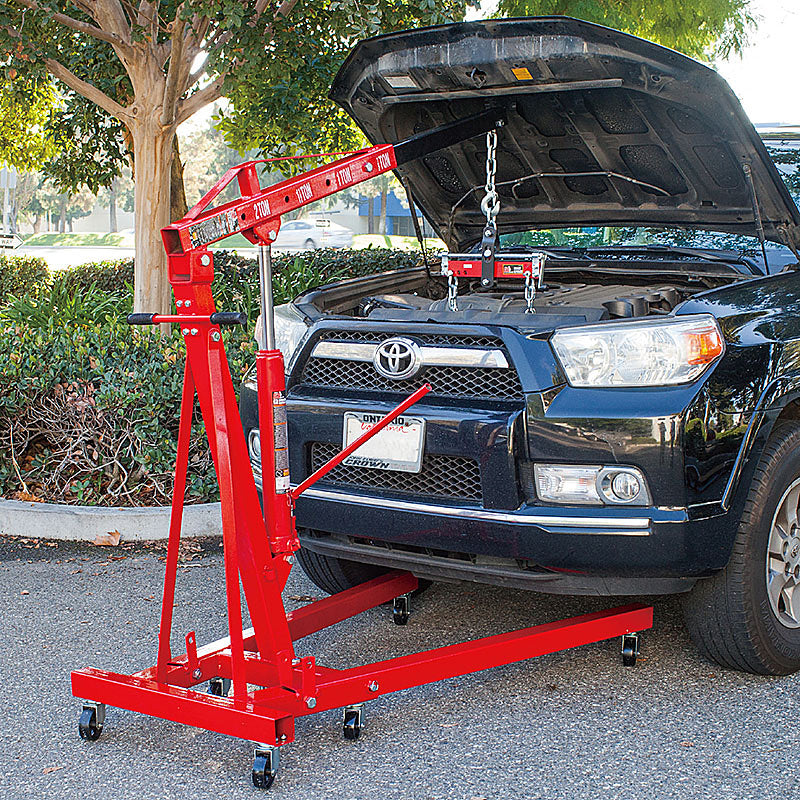Hydraulic engine cranes, often referred to as hydraulic engine hoists, are invaluable tools in industries ranging from automotive repair to construction. They provide the lifting power needed to handle engines and heavy loads. To ensure these essential pieces of equipment perform reliably by their weight capacity, preventive maintenance is key.
Here, we will delve into the importance of preventive maintenance for hydraulic engine cranes, providing insights and tips to help you maintain your equipment in optimal condition, particularly during heavy-duty operations.
The Significance of Preventive Maintenance
 Preventive maintenance isn't just a good practice; it's a necessity when it comes to hydraulic engine cranes. It's all about staying one step ahead of potential issues. By addressing problems early, you can extend the lifespan of your crane, reduce downtime, and maintain a safe working environment.
Preventive maintenance isn't just a good practice; it's a necessity when it comes to hydraulic engine cranes. It's all about staying one step ahead of potential issues. By addressing problems early, you can extend the lifespan of your crane, reduce downtime, and maintain a safe working environment.
Creating a Preventive Maintenance Schedule
 The foundation of successful preventive maintenance is a well-structured schedule. This schedule should encompass various maintenance tasks, including inspections, cleaning, lubrication, and hydraulic system checks. How often you perform these tasks depends on factors such as usage and environmental conditions.
The foundation of successful preventive maintenance is a well-structured schedule. This schedule should encompass various maintenance tasks, including inspections, cleaning, lubrication, and hydraulic system checks. How often you perform these tasks depends on factors such as usage and environmental conditions.
Inspection and Checklist
Regular inspections are at the heart of preventive maintenance. Create a checklist that covers critical components like hydraulic hoses, fittings, bolts, and structural elements. During inspections, keep an eye out for wear, damage, and any signs of leaks.
Cleaning and Lubrication
Cleanliness is a virtue in preventive maintenance. Keep your hydraulic engine crane clean and free from debris, which can cause damage over time. Lubricate moving parts to minimize friction and wear, ensuring smooth and efficient operations.
Hydraulic System Maintenance
 The hydraulic system is the powerhouse of your crane. Regularly check hydraulic fluid levels, inspect hoses for wear or damage, and ensure proper pressure levels. A well-maintained hydraulic system is essential for heavy-duty lifting tasks.
The hydraulic system is the powerhouse of your crane. Regularly check hydraulic fluid levels, inspect hoses for wear or damage, and ensure proper pressure levels. A well-maintained hydraulic system is essential for heavy-duty lifting tasks.
Structural Integrity
Don't overlook the structural integrity of your crane. Inspect the frame and components for cracks, rust, or deformities. A structurally sound crane is a safer crane, especially when handling heavy loads.
Record Keeping
Maintain meticulous records of your preventive maintenance activities. This documentation functions as a maintenance history, aiding you in tracking when you last performed tasks and in planning future activities. It can also be invaluable for warranty claims and troubleshooting.
Professional Servicing
While you can perform much of the preventive maintenance in-house, there comes a time when you need professional servicing. Consider scheduling professional inspections and servicing at regular intervals, especially for complex hydraulic systems.
In the world of hydraulic engine cranes, preventive maintenance is the secret to longevity, reliability, and safety. By adopting a proactive approach to crane care, you can maximize your equipment's lifespan, minimize downtime, and ensure efficient heavy-duty lifting operations.
If you're looking to browse or purchase an engine crane, don't forget to check out our product selection.
Keep your hydraulic engine crane lifting high and your maintenance worries low. Share your preventive maintenance tips with us in the comments!

